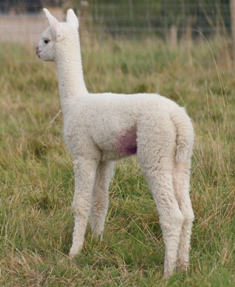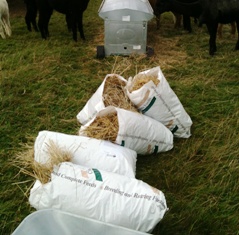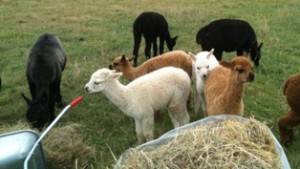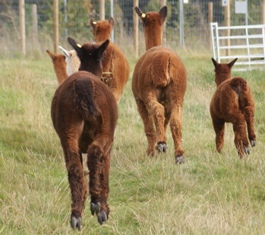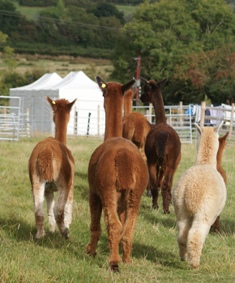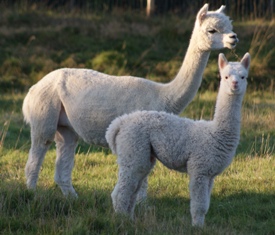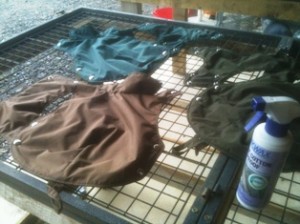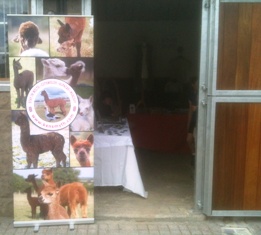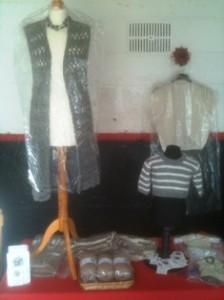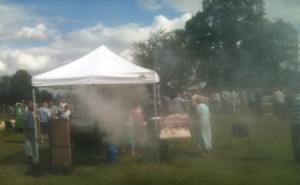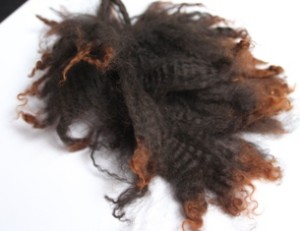Early Acorn drop – poisonous to Alpaca and can choke cria – beware
I do not often blog without a photo but I have had quite a few emails in the last few days about folk experiencing early Acorn falls.
Generally speaking Acorns fall late September through to November but as with many other things, its all happening early this year due to the warm weather. Folk are experiencing Acorns on the ground now and it is new acorns that are most toxic to all livestock, as they dry out and often burst, tannins are released and they are less toxic. Still a danger but less so as they are older and often removed by squirrels/mice by this time.
Whilst in a perfect world we do not really want Oak trees in livestock fields, they have many advantages in providing shelter from the elements too. We would always protect a tree rather than fell it and there are many ways of protecting livestock from access to eating acorns.
First of all, you can remove livestock from the field during this period and use it as a time to “rotate” your paddocks which is good pasture management ie rest that field. You can do this in a big field by erecting posts and a temporary fence between which is removed at a later time, when the acorns have been removed.
Alternatively, you can lay debris netting under the branches – obviously only viable in a small oak and not one of substantial size! – which collects the acorns which can be disposed of safely. not forgetting that they provide essential nutrients for other wildlife they could be “released” elsewhere away from your livestock for wildlife eg squirrels to eat.
alternatively you can use a paddock hoover to collect the acorns on a daily basis if the area is accessible.
If the oak belongs to someone else and it is only branches overhanging, then you can talk to the owner about cutting the branches down to remove the threat to your livestock which should not affect the tree if done when the sap is no longer rising. unfortunately this is after the acorn drop so if you haven’t thought about this yet – it is too late now to cut branches down this year.
of course there will be those amongst you who have Oak trees in their fields who have never experienced a problem and/or some Alpaca will eat a few to no effect. However, leaving them where Alpaca can access is not a sensible route as it is the “unknowledgeable cria” who usually fall victim by either eating young acorns when small or physically choking on them.
It is true that often older Alpaca will leave them alone but only if there is plenty of feed/grass/hay/other to eat and it is not a risk we would ever take or recommend.
Of course this is only my opinion and advice offered herein with best intentions.
I know many herds with Acorn trees in their fields who have never had a problem – they usually poover them up or keep the Alpaca out – but as always – prevention and being proactive is best!
September 1st 2014 Indian Summer ahead?
Well it is the first of September today and wow what a difference. yesterday was fantastic sunshine and today is drizzly rain. it is warm though and with the weathermen (what do they know) predicting and Indian Summer the log cabin will be super new ready for the winter. Farming is not just about the livestock – field maintenance, fencing maintenance and “house” maintenance too! Hubby donned some very attractive overalls and got on with it – no posh contractors here – just us!
see the before and after clearly… what a difference but pity about the smell!
Legendary Cria!
We are really proud of this little girl who is born to a super mum indeed. Her mother we purchased a number of years ago and her sire is Kensmyth Legend who is out of Aria who is by Peruvian Spartacus. Elite cria from Elite bloodlines and look at the result!
meantime – busy with husbandry duties and a lot of help in cleaning out all the hay racks to mix in new hay gently …
don’t you just love it when they tip the wheelbarrow over and try and take off with it!
Alpaca afternoon tea
Many folk know that we have special lanes around our farm for Biosecurity purposes and Alpaca moving… we also have the marquees for Events close to the farmstead and totally separate to the Alpaca grazed fields but they can see with ever increasing curiosity as to what is happening .
After an event last week, varying Alpaca had to be moved around tea time and although they do a hard left into a field… it did conjure up a certain caption in my imagination…
Any afternoon tea left?
pity about the washing on the line in the photo!
sunset on summer Alpaca – an Indian Summer?
well the sun has faded, the temperatures have dropped and the weather men still did not forecast the rain that came today.
Sometimes though, one looks at the winter with the welcome of the seasons and I am really pleased that, as I had as a child (showing my age) we seem to be getting more of a difference now. Autumn is definitely on the way, we definitely had a Summer and we definitely had a Spring this year. Winter is to follow.
Meantime, some of our cria are definitely setting their sights on the British Alpaca Society National Show 2015….
Kensmyth Alpaca Cria coats
Well today has been a funny old day weather wise – starting with around 11 degrees and not really getting that much noticeably higher because of the wind. What a change. Still, Autumn is on its way, blackberries are out, apples nearly ready and plums soon too. Hay and straw in the barn and fat chossy cria will be prepared for Mrs Winter.
Preparations for early cria always involve cria coating and now is a time that I take a good look at the coats and do the mending, washing and rewaterproofing. Cria coats are drying everywhere then waxed and dried again before putting away for next years babies due!
Yes that is a skirting table they are laid out on and I am only a quarter way through that job too!
Alpaca Walking 2014
well we have been busy with birthing and various husbandry issues and grass care but our Alpaca Walking has really taken off this year.
Mum wanted to see some of our first born Clay Meadow cria doing their jobs (ie yearling males) and so here we have a glimpse of the pleasure of Alpaca Walking at Kensmyth!!
Kensmyth Alpaca stand at VWH
I promised to come back to you on the Alpaca stand we took to the VWH event which was fab as usual. So lovely to be invited to display our lovely Alpaca stand and products. I even managed to catch up with my old Blacksmith… well he’s not old actually but its nearly 7 years we have been breeding Alpaca not horses now! Great fun had by all!
exhibiting in a stable was a first but the manger rings came in handy…
and Mitchell came too whilst hubby and Ollie looked after the pacas…
Mitchells Duck book display was fab… and the burgers were excellent – great turn out!
Sweet sixteen
Alpaca fleece colour tips
It is raining as I type which is really rather odd as it is 9 pm, pitch black and no rain forecast. zip in fact for tonight.
Nights are still warm and plenty of sunshine hopefully ahead for the rest of August. Would we be lucky enough to get an Indian Summer after the heatwave of this one I wonder?
In a previous blog, I mentioned that the true colour of an Alpaca is at the skin. I was quizzed on this lately by someone who did not know anything about Alpaca and I realised that it is quite difficult to explain “tipping” to someone not even remotely “farmy”.. so here goes.
When an Alpaca is born, it is released from the amniotic fluid which has surrounded it as it grew inside its Mother. This stains the outside of what then becomes the Alpaca Cria (baby) fleece.
This can be a totally different colour once the fleece is opened and therefore the colour first seen by the eyes may not necessarily be the colour underneath which is its “true” colour.
Soooo, in the Alpaca world, we open the fleece up to skin level and take the colour of the fleece inside at the skin to be the Alpaca colour.
Hopefully the following photograph clearly demonstrates that the colour brown at the tip of this fleece belies the fact that the Alpaca is Black.
The super Alpaca this came from is solid black and this was the cria fleece.
Archives
- December 2024
- November 2024
- October 2024
- September 2024
- August 2024
- July 2024
- June 2024
- May 2024
- April 2024
- March 2024
- February 2024
- January 2024
- December 2023
- November 2023
- October 2023
- September 2023
- August 2023
- July 2023
- June 2023
- May 2023
- April 2023
- March 2023
- February 2023
- January 2023
- December 2022
- November 2022
- October 2022
- September 2022
- August 2022
- July 2022
- June 2022
- May 2022
- April 2022
- March 2022
- February 2022
- January 2022
- December 2021
- November 2021
- October 2021
- September 2021
- August 2021
- July 2021
- June 2021
- May 2021
- April 2021
- March 2021
- February 2021
- January 2021
- December 2020
- November 2020
- October 2020
- September 2020
- August 2020
- July 2020
- June 2020
- May 2020
- April 2020
- March 2020
- February 2020
- January 2020
- December 2019
- November 2019
- October 2019
- September 2019
- August 2019
- July 2019
- June 2019
- May 2019
- April 2019
- March 2019
- February 2019
- January 2019
- December 2018
- November 2018
- October 2018
- September 2018
- August 2018
- July 2018
- June 2018
- May 2018
- April 2018
- March 2018
- February 2018
- January 2018
- December 2017
- November 2017
- October 2017
- September 2017
- August 2017
- July 2017
- June 2017
- May 2017
- April 2017
- March 2017
- February 2017
- January 2017
- December 2016
- November 2016
- October 2016
- September 2016
- August 2016
- July 2016
- June 2016
- May 2016
- April 2016
- March 2016
- February 2016
- January 2016
- December 2015
- November 2015
- October 2015
- September 2015
- August 2015
- July 2015
- June 2015
- May 2015
- April 2015
- March 2015
- February 2015
- January 2015
- December 2014
- November 2014
- October 2014
- September 2014
- August 2014
- July 2014
- June 2014
- May 2014
- April 2014
- March 2014
- December 2013
- November 2013
- September 2013
- May 2013
- March 2013
- February 2013


